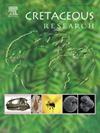西班牙昆卡vadilos -1非海相上巴雷米亚(下白垩世)介形类新种
IF 1.7
3区 地球科学
Q1 GEOLOGY
引用次数: 0
摘要
vadillo1的上巴雷米亚(下白垩纪)古生物遗址位于西班牙昆卡省北部。它是一个富非海相介形类的wealden型沉积层序。在这些资料中,已经确定了塞浦路斯的物种,特别是塞浦路斯的isasae,其特征是圆形的cyathus,和塞浦路斯的ventriosa,其特征是近圆形的轮廓和一个由非常明显的肺泡缺口分开的大喙。此外,还描述了许多塞浦路亚vatra 11 . sp.的标本,以其明显的前基角为特征,以及塞浦路亚marihoni 11 . sp.的标本,以其装饰的甲壳为特征。其他标本被归为环蝇属,特别是bamba十一月sp.环蝇属,其特征是其膨胀的甲壳和梨状的轮廓。这些分类群为研究区首次报道,具有冲积-滩相古环境特征。这一分析为未来的研究提供了基础,将允许对非海相巴雷米亚古环境进行更精确的解释。本文章由计算机程序翻译,如有差异,请以英文原文为准。
New species of ostracods from the non-marine upper Barremian (Lower Cretaceous) of Vadillos-1 (Cuenca, Spain)
The upper Barremian (Lower Cretaceous) palaeontological site of Vadillos-1 is located in the northern part of the province of Cuenca, Spain. It comprises a sedimentary sequence in Wealden-type facies, rich in non-marine ostracods. In these materials, species of Cypridea have been identified, in particular Cypridea isasae, characterized by its rounded cyathus, and Cypridea ventriosa, being distinguished by the subcircular outline and a large rostrum separated by a very marked alveolar notch. Additionally, numerous specimens of Cypridea vatra nov. sp., defined by its well-marked anterior cardinal angle, and Cypridea marihoni nov. sp., well defined by its ornamented carapace, have been described. Other specimens have been assigned to the genus Cyclocypris, specifically to Cyclocypris bamba nov. sp., characterized by its inflated carapace and piriform outline. These taxa are reported for the first time in the study area and are characteristic of alluvial and palustrine palaeoenvironments. This analysis provides the basis for future studies that will allow a more precise interpretation of non-marine Barremian palaeoenvironments.
求助全文
通过发布文献求助,成功后即可免费获取论文全文。
去求助
来源期刊

Cretaceous Research
地学-地质学
CiteScore
4.10
自引率
19.00%
发文量
235
审稿时长
12 weeks
期刊介绍:
Cretaceous Research provides a forum for the rapid publication of research on all aspects of the Cretaceous Period, including its boundaries with the Jurassic and Palaeogene. Authoritative papers reporting detailed investigations of Cretaceous stratigraphy and palaeontology, studies of regional geology, and reviews of recently published books are complemented by short communications of significant new findings.
Papers submitted to Cretaceous Research should place the research in a broad context, with emphasis placed towards our better understanding of the Cretaceous, that are therefore of interest to the diverse, international readership of the journal. Full length papers that focus solely on a local theme or area will not be accepted for publication; authors of short communications are encouraged to discuss how their findings are of relevance to the Cretaceous on a broad scale.
Research Areas include:
• Regional geology
• Stratigraphy and palaeontology
• Palaeobiology
• Palaeobiogeography
• Palaeoceanography
• Palaeoclimatology
• Evolutionary Palaeoecology
• Geochronology
• Global events.
 求助内容:
求助内容: 应助结果提醒方式:
应助结果提醒方式:


